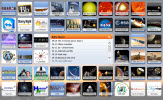November 2019
 The celestial highlight this month happens on the morning of November 11th, as the Sun rises, the innermost planet
Mercury will transit the Sun in an event that will be visible across the continental United States. The entire transit will be visible from the East Coast,
and the transit will be in progress farther west as the Sun rises. First contact will be at 12:35 UT (7:35 a.m. EST) as the leading edge of Mercury contacts the
edge of the Sun.
The celestial highlight this month happens on the morning of November 11th, as the Sun rises, the innermost planet
Mercury will transit the Sun in an event that will be visible across the continental United States. The entire transit will be visible from the East Coast,
and the transit will be in progress farther west as the Sun rises. First contact will be at 12:35 UT (7:35 a.m. EST) as the leading edge of Mercury contacts the
edge of the Sun.
Click here for the month at a glance calendar.

The Mercury transit in progress as the Sun
and Mercury rise above my local horizon.
Mercury moves from its eastern elongation into inferior conjunction and a transit of the Sun on the 11th. For about the last two weeks of the month moves into the morning skies and several days of great viewing from the Northern Hemisphere.
Venus remains low over the western horizon at sunset local time for this month, but gradually becomes more visible toward month's end, as it passes closely by the outer planet Jupiter.
Mars is slowly but steadily becoming more visible, rising earlier, over the eastern horizon as the distance between it and the Sun increases.
Dwarf Planet Ceres stays within about 4-5o from the planet Jupiter and 'mirrors' Jupiter's decreasing visibility and setting time.
Jupiter is still visible as an evening planet but it is gradually setting closer to the time for sunset and thus becoming more difficult to see.
Saturn, like Jupiter, is over the western horizon at sunset and like Jupiter is setting closer to the time of sunset and becoming more difficult to see.















 Above the Solar System at 10 day Intervals
Above the Solar System at 10 day Intervals


